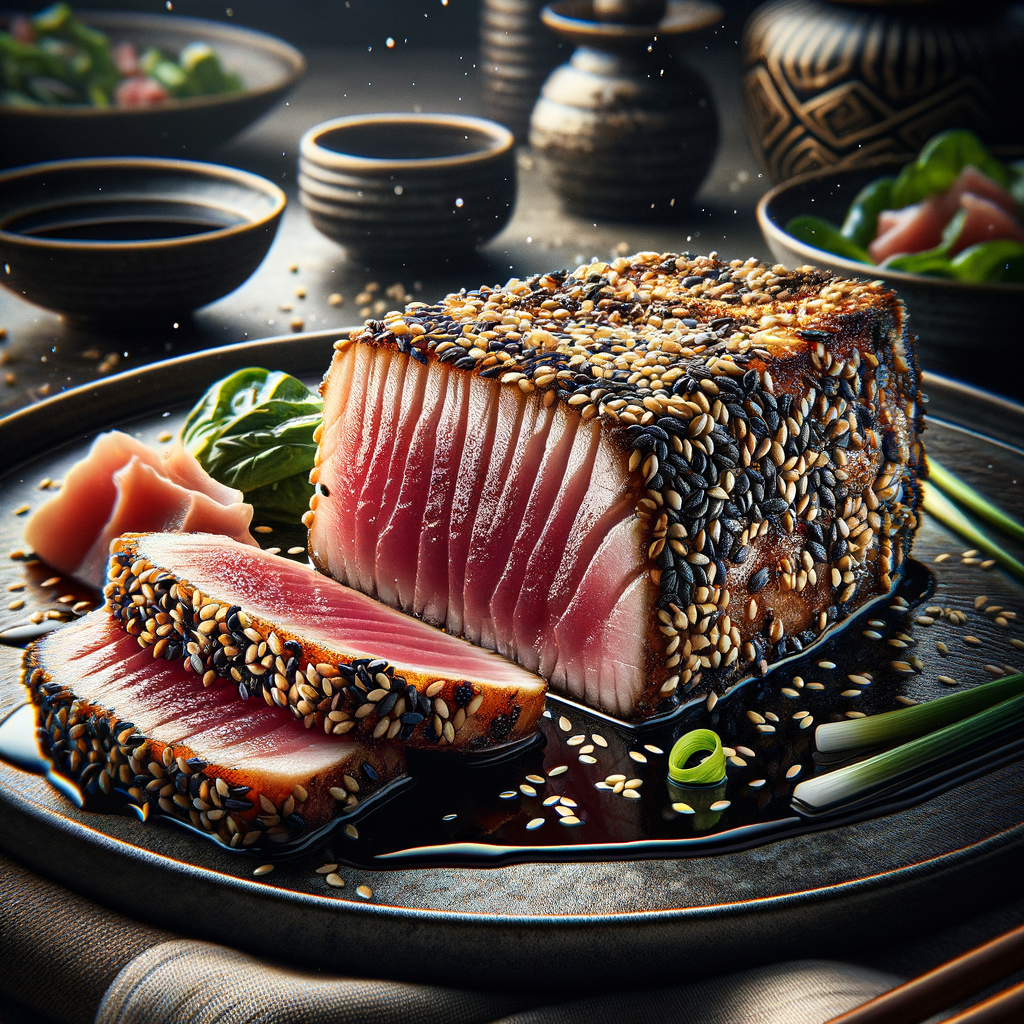Seared Tuna with Sesame Seeds: A Culinary Delight
 Within the realm of culinary arts, few dishes stand out for their simplicity, elegance, and the richness of flavors as Seared Tuna with Sesame Seeds. This dish, a staple in both home kitchens and upscale restaurants, embodies the essence of gourmet cooking while being surprisingly straightforward to prepare. In this comprehensive article, we will explore the history, nutritional benefits, and a step-by-step guide to creating this exquisite dish, ensuring that even novices can bring this culinary delight to their tables.
Within the realm of culinary arts, few dishes stand out for their simplicity, elegance, and the richness of flavors as Seared Tuna with Sesame Seeds. This dish, a staple in both home kitchens and upscale restaurants, embodies the essence of gourmet cooking while being surprisingly straightforward to prepare. In this comprehensive article, we will explore the history, nutritional benefits, and a step-by-step guide to creating this exquisite dish, ensuring that even novices can bring this culinary delight to their tables.
The History of Seared Tuna
The tradition of searing tuna is a technique borrowed from various cultures, each adding a unique twist to the preparation and presentation of this dish. The method of searing, which involves cooking the outer layer of the tuna at high heat while keeping the inside tender and moist, originated from Japan, where tuna holds a place of reverence in its culinary landscape. This cooking technique, combined with the western adaptation of encrusting the tuna with sesame seeds, has led to the creation of the modern Seared Tuna with Sesame Seeds dish as known today.
Nutritional Benefits of Seared Tuna
Tuna, the star ingredient of this dish, is renowned for its high protein content and significant amounts of Omega-3 fatty acids, which are essential for heart health and cognitive functions. When paired with sesame seeds, which are packed with healthy fats, minerals, and antioxidants, the dish becomes a powerhouse of nutrients. The searing process also ensures that the nutritional integrity of the tuna is preserved, making Seared Tuna with Sesame Seeds not only a treat to the taste buds but also a boon to the body.
Choosing the Right Ingredients
The success of Seared Tuna with Sesame Seeds lies in the quality of its ingredients. For the tuna, opt for fresh, sushi-grade tuna steaks that are bright in color and firm to the touch. The freshness of the fish will significantly impact the flavor and texture of the final dish. As for the sesame seeds, both white and black seeds can be used to create a visually appealing crust that’s also rich in flavor.
Preparing Your Tuna for Searing
Preparation is key to achieving the perfect sear on your tuna. Begin by patting the tuna steaks dry with paper towels to remove any excess moisture. This step is crucial for enabling the surface of the fish to achieve a beautifully caramelized crust. Next, season the tuna generously with salt and pepper to taste, and coat it evenly with sesame seeds, pressing them gently into the fish to ensure they adhere during the cooking process.
Searing Your Tuna to Perfection
The searing process is what sets this dish apart, creating a contrast between the crispy, nutty crust and the tender, raw interior of the tuna. To achieve this, heat a heavy skillet or griddle over high heat and add a small amount of oil with a high smoke point, such as sesame or avocado oil. Once the oil is shimmering, carefully place your tuna steaks in the pan. Sear for approximately 1-2 minutes on each side, depending on the thickness of the steaks and your desired level of doneness. Remember, the goal is to achieve a golden crust without cooking the tuna all the way through.
Finishing Touches and Serving Suggestions
Once seared to perfection, let the tuna steaks rest for a few minutes before slicing. This allows the juices to redistribute, ensuring each bite is moist and flavorful. Slice the tuna against the grain into thin slices for the best texture. Seared Tuna with Sesame Seeds can be served on its own, with a side of light soy sauce for dipping, or atop a bed of mixed greens for a complete meal. For a refreshing twist, consider adding a drizzle of wasabi mayo or a sprinkle of finely chopped scallions.
Pairing Your Dish with the Perfect Wine
A dish as refined as Seared Tuna with Sesame Seeds deserves a complementary wine pairing. White wines, particularly those with a crisp acidity such as Sauvignon Blanc or a dry Riesling, pair beautifully with the rich, oily nature of the tuna and the nutty flavors of the sesame seeds. For those who prefer red wine, a light Pinot Noir can also be a delightful choice to enhance the dining experience. Enjoy this culinary masterpiece with the perfect wine to elevate your meal to a true gastronomic delight.



